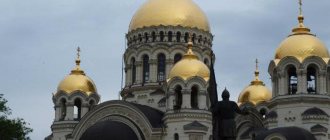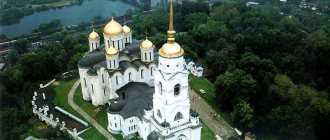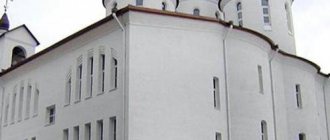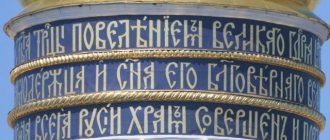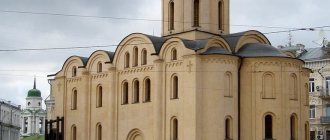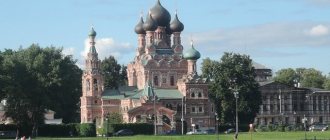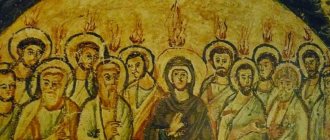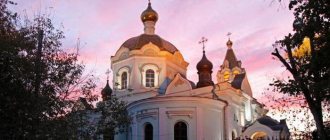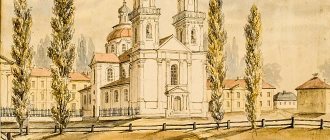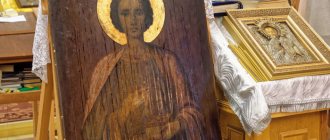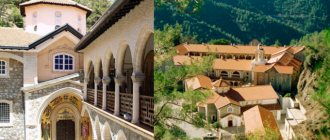The Intercession Cathedral is one of the main attractions of Sevastopol and at the same time an object of increased interest from the believing brethren. It is located in the very center of the city and is visible from anywhere in Sevastopol.
Intercession Cathedral at night, © Haidamac
The temple was erected at the beginning of the 20th century, so that it then went through a lot of crises: it was once the location of a temporary burial vault for the remains of Lieutenant Schmidt and the sailors of the cruiser "Ochakov" who died during the mutiny, a first-aid post, an infectious diseases hospital, a youth sports school, a bomb shelter, the State archive.
The building was also often robbed. There is evidence that over the course of its history, about 40 kg of gold and 100 kg of silver were taken from the cathedral; domes, crosses, bells and some icons were stolen.
Service in the Intercession Cathedral, © Intercession Cathedral VKontakte
Construction of the cathedral
In 1892, construction of the Intercession Church began in Sevastopol. The funds were raised by parishioners and philanthropists. In total, construction cost 134 thousand 500 rubles. The amount was quite large at that time. The architectural project was created by V. Feldman. He took the tented churches of the 16th century as a role model.
The temple was built over 13 years and consecrated on January 26, 1905 in honor of the Intercession of the Most Holy Theotokos. The cathedral received cathedral status. Five additional chapels were also consecrated. The upper ones are in honor of the supreme apostles and the holy martyr Panteleimon, the lower ones are in honor of:
- Prince Vladimir;
- Venerable Seraphim of Sarov;
- holy martyrs Faith, Nadezhda, Lyubov and their mother Sophia.
Cathedral of the Intercession of the Blessed Virgin Mary in Sevastopol
Exact location on the map, GPS coordinates: 44°36'18.7″N 33°31'19.3″E (44.605198, 33.522035)
Visiting places like the Intercession Cathedral provides an opportunity to completely escape from worries, calm down, and enjoy the grace of architecture. And to some extent even reconsider your actions. Even non-believers sometimes enter the temple, perhaps not even fully understanding why. And what do you think? Should non-believers visit such places? Have a nice, interesting holiday everyone!
All temples, cathedrals and churches of Crimea
Sights of Sevastopol – where to go, what to see?
Stanislav recommends:
- Where to relax in January
- Where to relax in February
- Where to relax in March
- Where to relax in April
- Where to relax in May
- Where to relax in June
- Where to relax in July
- Where to relax in August
- Where to relax in September
- Where to relax in October
- Where to relax in November
- Where to relax in December
History of the cathedral in Soviet times
After the revolution, the Intercession Cathedral was closed. It was discovered by the Germans during the occupation. During the hostilities, Sevastopol was bombed. Many buildings in the city center were damaged, including the Church of the Intercession, where the local population hid during air attacks. The bomb hit its southern part and destroyed two aisles - the upper and lower.
Important things about the Orthodox faith:
- Temple, cathedral, church and monastery
- About Orthodox symbols
- Why do Orthodox Christians build many churches and not hospitals?
Interesting!
The restoration of the cathedral was carried out by Father John Krashanovsky, who was appointed rector there in 1947. He managed to more or less restore the church within a year. The temple was re-consecrated and, for 14 years, services were held there. In 1962, the church was closed again by decision of the Soviet authorities. The cathedral began to be used as a city archive building and a gym.
How to get to the cathedral?
The area where the architectural masterpiece is located is called Leninsky. A more precise location of the temple is the western shore of the South Bay. The closest stop to this place is “Bolshaya Morskaya”. There are 11 bus routes and the same number of trolleybuses. Some of them come from railway and bus stations.
By car you can get to the Intercession Cathedral in the following way:
Note to tourists
- Address: Bolshaya Morskaya street, 36, Sevastopol, Crimea, Russia.
- Coordinates: 44.605262, 33.522145.
- Phone: +7-8692-54-54-84.
- Official website: https://sevpokrov.ru/
- Opening hours: from 7:00 to 19:00.
- Schedule of services: in the morning - at 7:00, in the evening - at 17:00. Look in detail at https://sevpokrov.ru/
For many of us, everything that happens is perceived as monotony. A person who is tired of the “bursts” of life needs constant mental balance. Then a visit to the Intercession Cathedral in Sevastopol is a long-awaited gift! Finally, watch a short video about this attraction.
Liked? Share with your friends!
Architecture
The cathedral is made like a basilica, in the style of Russian churches of the 16th century. The temple is five-domed, pillarless, decorated with turrets, cornices and semicircular kokoshniks. Adjacent to the church is a hipped bell tower and a refectory. The porch is made in the form of a closed gallery. The walls inside are painted.
Read about Orthodox churches:
- Internal and external arrangement of the Orthodox church
- Who is the bishop in the church
- Elder in the church
Intercession Cathedral in Sevastopol, iconostasis
Patronal holidays of the Intercession Cathedral:
- October 14 - Intercession of the Blessed Virgin Mary;
- August 9 - memory of the Holy Great Martyr Panteleimon;
- July 12 is the day of remembrance of the supreme apostles Peter and Paul;
- July 28 - memory of Saint Prince Vladimir;
- January 15 and August 1 are the days of memory of St. Seraphim of Sarov;
- September 30 is the memory of the holy martyrs Vera, Nadezhda, Lyubov and their mother Sophia.
Schedule of services of the Intercession Cathedral
On the official website of the cathedral you can always see the current schedule of services, as well as holidays celebrated by the church. The schedule of services is tied to the Russian Orthodox calendar.
Divine services in the temple are held every day. Morning worship begins at 7 o'clock, at which time the Divine Liturgy is held. At 5 p.m., believers can attend the Evening Service, which takes place at the same time as the Sacrament of Confession. Every day a prayer service and a memorial service are held in the cathedral. On Friday, at 16:00, those who wish can attend a prayer service with an akathist to the Most Holy Theotokos, which is performed in front of the “All-Tsarina” icon.
On weekends, the Divine Liturgy begins at 8 a.m.
© miljkovic14
Interior decoration
Vladimir Cathedral (Sevastopol) is designed in accordance with the idea of a multifaceted structure: an Orthodox church for prayers, a tomb of great naval commanders, a city museum. In accordance with this: the upper temple is the House of God; the lower one is a crypt and a museum.
Upper Temple
The temple for prayer is solemn, majestic and spacious in height. The supporting structure resembles a cross-dome system, which is not complicated in any way. The high vaults rest on a group of 4 marble columns. The Byzantine style is indicated by floral and geometric decor in pastel colors. The lighting is very interesting: round porthole windows are covered with multi-colored glass.
The marble iconostasis is low, does not completely cover the room and allows you to see the wall paintings in the altar. Along the perimeter of the room, at eye level, there are memorial plaques. There are 81 of them (31 with names).
Lower Temple
First of all, here is the tomb of the great admirals who laid down their lives for Sevastopol. Everything is very simple, modest, even ascetic. Snow-white walls, low vaulted ceilings are supported by strict all-stone columns. No-frills iconostasis.
A little to the side is the crucifixion of Christ, and in the center of the hall are the graves of admirals Lazarev, Kornilov, Istomin and Nakhimov, which are united by a common tombstone in the form of a lying cross.
Vladimir Cathedral lower temple (Sevastopol)
A small hall houses the museum's exposition, where visitors are not allowed without a guide. Here they talk about the difficult history of the city, the creation and development of the military Black Sea Fleet, and the maritime Vladimir Cathedral. The collection is called: “The cross shines with a golden radiance over the saint’s tomb.”
It presents preserved historical objects, documents and photographs telling about the life of the admirals buried here, about the people who built and restored the cathedral.
Don’t miss the most popular article in the section: Map of the Black Sea coast of Russia with resorts: cities and towns.
Outstanding ministers of the Crimean diocese - Archbishops Luka, Gury and Dimitry
Among the ministers of the diocese there were truly outstanding personalities who deserve special attention.
Archbishop Luke. In addition to theological education, he also had a higher education, was a professor-surgeon, was an active doctor, and was a candidate for the Stalin Prize.
1946
from this year Luke was appointed archbishop in the Tauride diocese
Since 1946 he was archbishop in the Tauride diocese. In 1995, he was canonized by the Synod of the Ukrainian Orthodox Church.
In 1997, a monument was unveiled in his honor. The relics of the holy bishop are kept in the Holy Trinity Monastery in Simferopol, the capital of Crimea.
Another important figure in the history of the Crimean diocese was Archbishop Gury.
Real name: Grigory Platonovich Karpov. Being the head of the Tauride Department, he was active for 14 years.
Under him, the Theological Seminary and the Theological School for Men were financed and built. Under him, the Alexander Nevsky Cathedral was reconstructed. Under him, the Tauride Theological Seminary was founded, and the magazine “Tavriche Diocesan Gazette” was published.
Archbishop Gury died in 1882, and in 1929 his body was transferred to the Simferopol cemetery of the Church of All Saints.
An interesting fact is that there is a certified fact that 47 years after burial, Guria’s body remained incorrupt.
2008
this year Bishop Gury was canonized
Archbishop Dimitri also performed many good deeds for the fate of the Crimean diocese. His administration of the diocese occurred during the First World War. At the beginning of the war he was a priest at the Black Sea squadron.
Also during the war years he took part in the work of the Provisional Higher Church Administration in the South of Russia. He spent his dying years in the Kiev-Pechersk Lavra.
Interesting facts and legends
The Vladimir Cathedral was built from Inkerman stone (bryozoan limestone), mined on the outskirts of Sevastopol. It has been widely used in construction since ancient times. Not only were many snow-white buildings of the city and Russia built from it, it was actively exported by the ancient Romans, who valued the material for its beauty, strength and flexibility in processing.
In Russia, architects used it to build majestic, state-owned buildings in Moscow and St. Petersburg, and the Livadia Palace was built from it. Experts are amazed by the strength of the stone: structures erected in the 19th century still do not require major repairs to the walls, and during the earthquake in Crimea (1927), not a single structure made from it collapsed.
Traditions established in the 19th century are still maintained in the cathedral. It so happened that the crypt for the fallen admirals of the Black Sea Fleet was erected much earlier than the completion of construction and consecration of the temple itself. That’s why even the unfinished building was always visited by sailors who considered this church theirs.
And after consecration it remained “sea”. The cathedral did not have a parish, and therefore all the auxiliary work in preparing and conducting divine services was done by the sailors themselves.
Divine services were held only on Sundays, on church holidays, on dates honoring members of the imperial family and, of course, on memorial days associated with the defense of Sevastopol.
Today, the “sea” Vladimir Cathedral holds obligatory prayer services on the same days, in addition to scheduled prayers. Memorial services have been added for those who died in all wars of the 20th century and on the Kursk submarine.
At Cape Chersonese, where it was initially planned to install the cathedral described above, a monument to the Baptism of Prince Vladimir into the Orthodox faith nevertheless appeared.
Since 1861, in parallel with the construction of the cathedral-tomb in the center of Sevastopol, the Chersonesus Tauride Vladimir Cathedral was built according to the design of D.I. Grimm in the New Byzantine style.
Its consecration also took place 30 years later. The further fate of the two temples is very similar; the restoration of Chersonesos was completed in 2004. Today it is the cathedral of the Simferopol and Crimean diocese.
